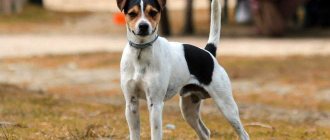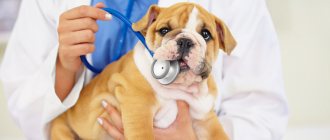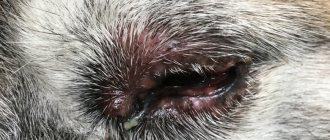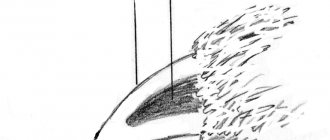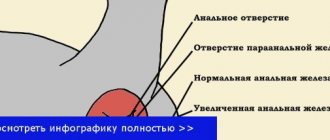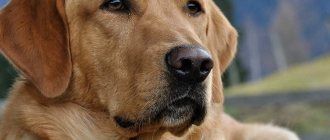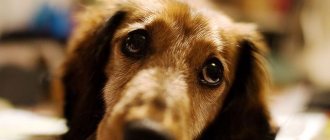A complex disease associated with the inflammatory process in the gum tissue is called gingivitis. Due to advanced disease, the animal may lose teeth or the infection may spread to other internal organs. A seemingly harmless disease can have serious consequences. Gingivitis can occur in acute or chronic form, covering the entire surface of the gums or spreading locally. What is gingivitis in dogs and how to deal with it, read on.
Symptoms of gingivitis development
In the first days there is weakness and refusal to eat. Thirst and appetite persist. The dog approaches the feeder, but cannot eat due to the pain that occurs when chewing. A painful attack is accompanied by whining or squealing. Due to poor nutrition, weight decreases.
The disease develops gradually. Periodic improvement in well-being followed by relapse is possible. The more symptoms of inflamed gums a dog has, the worse his condition. Symptoms of gingivitis in dogs include:
- dense plaque on the teeth and mucous membranes of a yellow-red or gray-brown color;
- swelling and redness of soft tissues;
- bleeding when chewing and loose teeth;
- profuse drooling;
- small ulcers in the mouth;
- discharge of pus when pressing on the swollen areas;
- blue discoloration of the soft areas between the teeth.
The most striking sign of pathology is an unpleasant and pungent smell of rot from the oral cavity. Its appearance is typical for a particularly severe form. When an abscess occurs, that is, purulent inflammation of tissues, the general temperature rises. In such cases, treatment for gum disease in dogs should begin immediately.
Causes
Gums can become inflamed for various reasons. Thus, animals that have tartar under their gums are at risk. Even though it is difficult to notice, it causes a lot of inconvenience. In dogs, tartar irritates the gums and contributes to the development of inflammatory processes. As a result, periodontitis and periodontal disease develop, growths, fistulas, and abscesses form.
Another reason lies in the bones that owners “pamper” their pets with. Under the influence of sharp fangs, the bones split and literally cut the gums with their sharp edges. To protect your pet from oral diseases, it is necessary to create a clear feeding schedule. In dogs that eat haphazardly, food debris accumulates between the teeth and causes an inflammatory process.
Four-legged animals that have reached old age are at risk. Older dogs often exhibit hyperplasia (tissue growth) and all kinds of neoplasms. Diagnosis is made by taking biopsy material for histology.
Most often, small and decorative breeds suffer from gum inflammation, such as Pekingese, Yorkshire terrier, dachshund, chihuahua, lapdog, toy terrier, cocker spaniel, miniature and small poodles.
What factors and diseases cause gingivitis?
Dental diseases most often occur in older animals. With age, the quality of teeth deteriorates and immunity decreases. It is impossible to prevent this factor. Fortunately, other causes are related to diet, oral care and other pathologies. All of them are treatable and preventable.
Helminthiasis
Vitamin deficiency and helminthiasis are closely related. When parasites infect the body, they destroy some of the incoming nutrients. There is an acute shortage of ascorbic acid.
This reason is rarely diagnosed, since the dog’s body independently synthesizes vitamin C. The situation changes with a severe form of helminthic infestation, when the body is too weak. The routes of entry of ascorbic acid are blocked not only from the outside, but also from the inside. Helminthiasis is most severe in puppies.
Tartar
If the mucous membranes are inflamed due to tartar, then there is a high probability of periodontitis. The fossilized plaque gradually grows into the gum pocket, peeling off the soft tissue. The wider the pocket, the worse it holds the tooth root. The animal requires urgent treatment aimed at preserving its teeth. A veterinarian-dentist will tell you how to treat gingivitis in dogs of this form - in the worst case, surgical intervention will be required.
Poor nutrition
The condition of the oral cavity is affected not only by the amount of vitamins, but also by the type of feeding. A dog's gums bleed due to food that is too rough or, conversely, too soft. In the first case, solid food particles injure soft tissues, leaving small cuts. In the second case, either tartar forms or the mucous membranes loosen. To avoid consequences, it is important to combine both types of nutrition.
Autoimmune disorders
Sometimes the mucous membranes swell in completely healthy pets. If you are confident in the quality of your pet’s diet and regular oral hygiene, check it for autoimmune disorders. With this diagnosis, the body perceives native cells as foreign bodies and destroys them. It is impossible to predict this pathology, but it is quite possible to keep it under control.
Changing baby teeth
Red gums in a dog aged 3 to 7 months are associated with the change of baby teeth. This process is unpleasant and takes a lot of effort. Due to decreased immunity, vulnerability to infections increases. During this period, it is not recommended to vaccinate or increase physical activity.
Allergies
When interacting with an allergen, the production of histamine, the substance responsible for the allergic reaction, increases. It is transmitted into the blood, increasing the permeability of blood vessels. Not only native substances penetrate into the formed pores, but also foreign ones. Without taking antihistamines, secondary infections are added to allergies.
Diseases of the internal systems of the body
In the chronic form of the pathology, deep functional impairments are often found. In this case, the pathology is secondary and is treated only after the primary disorder has been eliminated. Gingivitis can be caused by pathological processes in internal organs: kidneys, liver, digestive tract, even in the respiratory tract.
What is gingivitis
The medical term “gingivitis” is of Latin origin and consists of the root “gingiva” - gum and the suffix “-itis”, traditionally applied to diseases characterized by an inflammatory process.
Did you know? Almost always, the names of inflammation in medicine are etymologically the Greek name of a specific organ with the addition of the word form “-itis”, indicating the nature of the course of the disease. For example, pancreatitis, or pancreatitis, where πάγκρεας (pancrea) is the pancreas, gastritis, or gastritis, where γαστήρ (gaster) is the stomach, etc.
Thus, gingivitis, both in humans and in dogs, is usually called any inflammation of the gums that occurs in a fairly mild form, but is accompanied by swelling, redness, and possible bleeding of the tissue of the oral mucosa covering the teeth in their lower part.
With gingivitis, the connection between the tooth and the gum retains its integrity, but in the absence of adequate treatment, the pathological process can develop into more dangerous conditions, incl. cause complete or partial tooth loss.
Types of gingivitis
Gingivitis in dogs is classified according to the severity of symptoms, location of occurrence and form of manifestation. Depending on these factors, 6 types of pathology are distinguished.
Acute and chronic
The acute form is characterized by vivid symptoms and rapid deterioration of well-being, while the chronic form is characterized by a smoothed clinical picture, periodic improvements and relapses. The chronic form is more dangerous because it is difficult to diagnose early.
Localized and generalized
In the localized form, the inflammation manifests itself as a point, and in the generalized form the process covers all soft tissues. In the latter case, the treatment still affects the entire oral cavity.
Catarrhal (serous) and hypertrophic
The catarrhal form occurs due to the influence of external factors (trauma, bacteria and viruses, allergens), the hypertrophic form - due to the influence of internal factors (diseases of the gastrointestinal tract and cardiovascular system, hormonal disorders, blood diseases).
In the hypertrophic form, inflammation is localized on the canines, incisors and molars. Depending on the symptoms, it can be edematous or fibrous. In the second case, in addition to redness and swelling, ulcerations appear on the mucous membrane. The fibrous form is often found in older dogs, large breeds and collies.
List of gum diseases accompanied by inflammatory processes
There is a list of gum diseases that are accompanied by an inflammatory process:
- Tartar. Inflammation of the gums most often develops due to such plaque. It can be supragingivial (formed on the outer surface of the teeth) or subgingivial (accumulates under the gum, on the roots of the tooth, and can spread to the crown). In the first case, the plaque is beige or yellow, in the second it is dark green.
- Periodontal disease. Develops against the background of infections, bacterial or fungal diseases. Periodontal disease can also be the result of vitamin deficiency. Some breeds (especially Chihuahuas) are predisposed to periodontal disease (the tissue that holds the teeth in the jaw).
- Periodontitis. Develops due to excessive deposits of tartar. The disease is accompanied by lymph nodes, and an unpleasant odor appears from the mouth. Inflammation of the gums can lead to the appearance of blood in the saliva. At the last stage, there is a risk of tooth loss due to the resorption of bone tissue surrounding the tooth roots. Gums can become inflamed not only due to disease, but also due to injury. Bacteria penetrate into the wound and begin to actively multiply. As a result, the inflammatory process begins.
Methods and means of treatment
If you do not have the opportunity to visit a veterinary clinic immediately after detecting alarming signs, provide first aid. To relieve acute pain, use a decoction of calendula or chamomile, and to slow down the inflammatory process, use a weak solution of soda. Remember that these measures are effective only at the initial stage of the disease.
After visiting a veterinary clinic, the doctor diagnoses the symptoms of gingivitis in the dog and prescribes treatment. When examining the oral cavity, the condition of the teeth, mucous membrane and gum pocket is determined. A four-legged patient gets an X-ray of his mouth. The image clearly shows any damage to hard bone structures.
Additionally, a Schiller-Pisarev sample is taken. This diagnostic method involves using the properties of iodine. When the substance is applied to the affected areas, their color changes to brown. The more intense the resulting shade, the more serious the inflammation.
At the veterinary clinic
Treatment of severe gum inflammation in dogs takes place strictly under the supervision of a veterinarian. A hospital stay will be required for surgical operations. Depending on the situation, the four-legged patient may require excision and suturing of the affected tissue or removal of diseased teeth. When cleaning dental pockets from pus (gingivectomy), general anesthesia is used. To avoid complications after the operation, the animal is kept in the hospital.
Tartar is removed using ultrasound. This is an unpleasant procedure, so, like gingivectomy, it is performed under general anesthesia. Treatment of gums in dogs is not complete without physiotherapeutic procedures. Patients are given:
- soft tissue massage;
- electrophoresis - subcutaneous administration of liquid drugs (calcium, heparin, chlorine) through a constant electric current;
- thermocoagulation of gingival papillae - selective removal of damaged areas using high-frequency waves without destroying the epidermis.
All other therapy comes down to taking medications and treating inflamed tissues, so it is carried out at home.
At home
Treatment for gum disease in dogs includes rinsing and debridement. For rinsing, decoctions of chamomile, yarrow, oak bark and sage are suitable. These plants not only disinfect wounds, but also relieve inflammation. Remember that before use you must consult a veterinarian, since herbs are one of the strongest allergens.
How to rinse your dog's mouth:
- Draw warm liquid into a large-volume syringe without a needle. For giant breed dogs, you can use the Janet syringe.
- Tilt the dog's head and open its mouth slightly.
- Pour a stream onto the dog's gums so that the liquid does not enter the throat. It will pour out onto the floor - you can substitute a basin or lay a cloth.
- It is advisable to rinse not only the inflamed areas, but also the entire oral cavity.
When removing plaque, use a regular cotton pad soaked in peroxide or chlorhexidine. The procedure is carried out several times a day. During rehabilitation, it is important to keep your mouth clean. Avoid the accumulation of stuck food pieces. They can be easily removed with a child's toothbrush. Instead of toothpaste, a weak solution of soda will do. Clean daily until complete recovery.
Sea buckthorn oil is used as a folk remedy, but it is safer to purchase a special healing gel. It adheres more firmly to the surface, which increases the duration of the therapeutic effect and dulls attacks of pain. A veterinarian-dentist will tell you exactly how to treat inflammation of the gums in dogs - he will also advise you on the dosage and show you how to carry out therapeutic procedures at home.
In addition to antiseptic treatment, the animal is often prescribed antibiotic therapy. The dosage of all drugs is determined by the doctor. Among folk remedies, infusions of calendula, chamomile or echinacea are suitable. They can be consumed as a drink or used as a rinse.
Ulcerative inflammation of the gums in dogs is treated with herbal infusions. To prepare the infusion, mix oak bark, chamomile, sage and thyme in equal proportions. Pour 1 tbsp. l. herbal mixture with a glass of boiling water and leave until completely cool. Strain the cooled infusion and rinse your pet’s mouth with it 4-5 times a day. Cauterization of erosive lesions is unacceptable. Such exposure will aggravate the condition of the affected tissues.
For helminthiasis, anthelmintic drugs are used. Raising immunity is stimulated by multivitamin complexes. The emphasis is on vitamins B, P, C and PP.
The duration of therapy is determined by the stage of the disease. In the initial stages, healing occurs quickly and without complications.
How to treat gingivitis in a dog at home
Treatment of gingivitis is always individual, since it directly depends on both the severity of the disease and its form.
At the same time, as a general rule, providing assistance to a patient involves the sequential or parallel performance of three important tasks:
- relief of the most painful symptoms of oral lesions;
- anti-inflammatory therapy (general and local);
- identifying and eliminating the underlying causes of the disease.
First aid
As a first-priority measure for treating gum inflammation, it is necessary to identify and eliminate the obvious, direct cause that caused it, if any. For example, the soft tissues of the oral mucosa may be subject to the traumatic effect of an improperly growing tooth or a splinter that has entered the gum after the animal enthusiastically gnawed on an object not intended for this purpose. As a rule, however, such negative factors are precisely dental plaques or stones that need to be removed. After the procedure, preventative grinding and polishing of the teeth with a special brush and paste is also required in order to smooth out all roughness and plaque residues.
Important! Without polishing, plaque appears again much faster than it formed before brushing. This is explained by the fact that food debris and mucus stick to an uneven surface much more easily.
Modern methods of removing tartar in dogs involve the use of ultrasound, making the process safe and generally causing virtually no pain in the animal. However, without anesthesia it is impossible to get into a dog’s mouth and carry out long-term manipulations there, so it is recommended to carry out cleaning with the use of sedatives.
Their effect is much milder than that of ordinary local and, even more so, general anesthesia; the animal remains conscious, but is in a half-asleep state, excluding both stress and aggression. In particularly difficult cases, it is necessary to remove those teeth that are no longer viable, but remain a source of pathogenic microflora.
Important! In the vast majority of cases, removal of plaque and ultrasonic teeth cleaning leads to a complete cure for gingivitis, and the animal no longer requires additional therapy.
As general strengthening procedures and measures, the animal may also be prescribed:
- electrophoresis with heparin (in the form of a solution);
- gum massage;
- spot diathermocoagulation;
- other methods of physiotherapy;
- vitamin supplements (the emphasis is necessarily on ascorbic acid, niacin, and B vitamins) and flavonoids. A course of taking vitamins usually lasts about a month.
Drugs
Chronic or advanced gingivitis requires more serious complex therapy. It can be either local (treatment with antiseptics, special gel applications on the gums, etc.) or general.
The first place in the treatment of severe forms of gingivitis is occupied by drugs that have antiseptic, antibacterial, wound-healing and at the same time immunostimulating effects. “Argumistin” has proven itself very well in this regard. It contains the antimicrobial drug miramistin, as well as particles of colloidal silver. The first component loosens the bacterial cell membrane and facilitates the penetration of silver into it, which, in turn, completely blocks the pathogen.
The course of treatment with Argumistin, depending on the severity of the pet’s condition, lasts from 10 days to 2 weeks and involves daily two or three applications of the drug to the gums. In addition to antiseptics, treatment of gingivitis may also involve the use of so-called symptomatic medications, i.e. drugs designed to alleviate the general condition of the animal. These include, in particular, various decongestants, for example:
- "Maraslavin";
- "Polimenerol";
- copper sulfate 3%.
They are usually used topically, using gum treatment or applications.
Did you know? Surprisingly, gingivitis is one of the TOP most common diseases in the world. According to statistics, gum inflammation in one form or another is observed in 70% of the world's population.
To strengthen the epithelium of the gum mucosa affected by inflammation, the doctor sometimes prescribes so-called keratoplastic and sclerotizing (stimulating the formation of connective tissue) drugs, such as:
- "Phytodent";
- "Karatolin";
- "Maraslovin";
- ichthyol ointment;
- sea buckthorn oil;
- rosehip oil;
- potassium iodide;
- copper sulfate.
For the same purpose, injections into the gums of a solution of glucose (40%) and hydrogen peroxide (10%) can be performed. When using a needleless injector, the procedure for the animal is painless.
Further, complex treatment of gingivitis sometimes involves the use of drugs aimed at suppressing the development of certain enzymes that can significantly accelerate the inflammatory process or lead to certain complications.
For example, this category of funds includes:
- "Heparin" - blocks the production of hyaluronidase and, thus, improves the permeability of blood vessels and tissues;
- "Kontrikal" - slows down the synthesis of cathepsins (tissue proteases);
- "Trasylol" - the action is similar to Contrikal.
Anti-inflammatory therapy in certain cases should be combined with hormonal drugs and so-called biogenic stimulants. One of the most common products in this group is aloe extract. It is important to remember that biogenic stimulants have a number of important contraindications, which include, in particular, the period of pregnancy and estrus, as well as the presence of any neoplasms in the animal.
Treatment of severe forms of hypertrophic gingivitis may require surgery to excise the affected area of the gum. Finally, it is important to remember that for successful treatment of inflammatory processes in the oral cavity, it is necessary to accurately determine the cause of their occurrence and, if it is associated with general diseases of internal organs and systems, these pathologies should be treated.
For gingivitis caused by diseases of various body systems, treatment of these systems is necessary. Treatment of gingivitis involves influencing the pathological focus in the periodontium and the animal’s body as a whole, therefore it is conventionally divided into local and general.
Diet during treatment
Since we are not talking about systemic disorders of the gastrointestinal tract, your pet does not need to select any special dietary food. It is enough just to make sure that the food is, if possible, soft and viscous - in order to avoid irritation and injury to already painful gums. At least until the symptoms of acute inflammation are relieved, the dog should not be given bones, various chews and other treats with a dense texture. In addition, after each feeding, it is advisable to treat the oral cavity with chlorhexidine (0.05% solution) in order to prevent the proliferation of pathogenic microflora and the development of infections.
Did you know? In 2011, John Lennon's molar was sold at auction for $30,000. To this day it is the most expensive tooth in the world.
Dog menu during treatment and rehabilitation
Treatment of gums in dogs requires a mandatory diet. The animal is transferred to high-protein super-premium or holistic-class soft food. They do not injure the mucous membrane and contain all the vitamins necessary for recovery. After each feeding, the oral cavity must be rinsed with chlorhexidine solution. This will prevent stuck pieces of food from rotting.
If it is impossible to purchase specialized feed, you will have to temporarily switch to natural feeding. In this case, the menu is reduced to pureed vegetables and meat. Such food will have to be cooked until the pain disappears. As soon as the patient’s condition improves, switch to boiled rabbit, veal or chicken.
Three times a week, treat your dog with low-fat cottage cheese, kefir or natural yogurt. They will replenish calcium reserves and strengthen bone tissue. To restore vitamin A, serve boiled sea fish, cleaned of bones, once a week.
The usual diet is returned no earlier than 3 months from the start of therapy. If your dog is used to eating dry food, do not rush to return it to the diet for another 2 months after recovery. Remember that the transition to your previous diet should be smooth. Otherwise, there is a high probability of intestinal problems.
Are my dog's gums naturally black??
If we observe that our dog has black gums, the first thing we should do is determine if they are turning black. Some dogs have a natural black pigment in their mucous membrane that is what your gums form. The reason for this is genetic, the same reason why dogs have different coat colors. This doesn't mean there is a problem..
Not many dog breeds have this trait, although some dogs are more likely to have it than others. Few have mouths, tongues or gums that are completely black, but some occur naturally as comedones . Sometimes the coloration appears black or purple rather than black, but several shades are possible.
Dog breeds that may have completely black gums or black spots in the mouth include:
- Chow chow
- Shar pei
- Dalmatian
- Australian Shepherd
- Irish Setter
- Pit bull breeds
- Mastiff plays
- Newfoundland
The color and quality of our dog's gums are an indicator of the dog's overall health. If your dog's gums are abnormally black, it could be a sign of several health problems. However, if your dog's gums are too pale, too red, or a different color than usual, this could be a sign of problems. For example, bluish gums may indicate cyanosis , a condition in which a lack of oxygen reaches the mucous membranes. Tender gums may be a sign of jaundice.
We need to know whether any black coloration in our dog's mouth is natural or whether the black spots appear unnaturally. An important way to differentiate between the two is to observe any accompanying symptoms. If your dog has black gums and bad breath (in addition to the dog's natural breath), it could be a sign of a medical problem. Tooth loss, bleeding, inflammation and other signs can also help us determine the cause.
Dog feeding diet
During treatment, the dog's feeding diet must be changed. The food is pre-ground to a puree. The optimal food temperature is 34-37 degrees. After each meal, the animal’s oral cavity is irrigated with antiseptic solutions in order to remove food debris.
If the dog eats dry food, it is better to switch it to wet canned food during the treatment period. You can also soak hard crackers well before feeding, and then grind them with a blender. After complete recovery, the pet is transferred to its usual diet.


